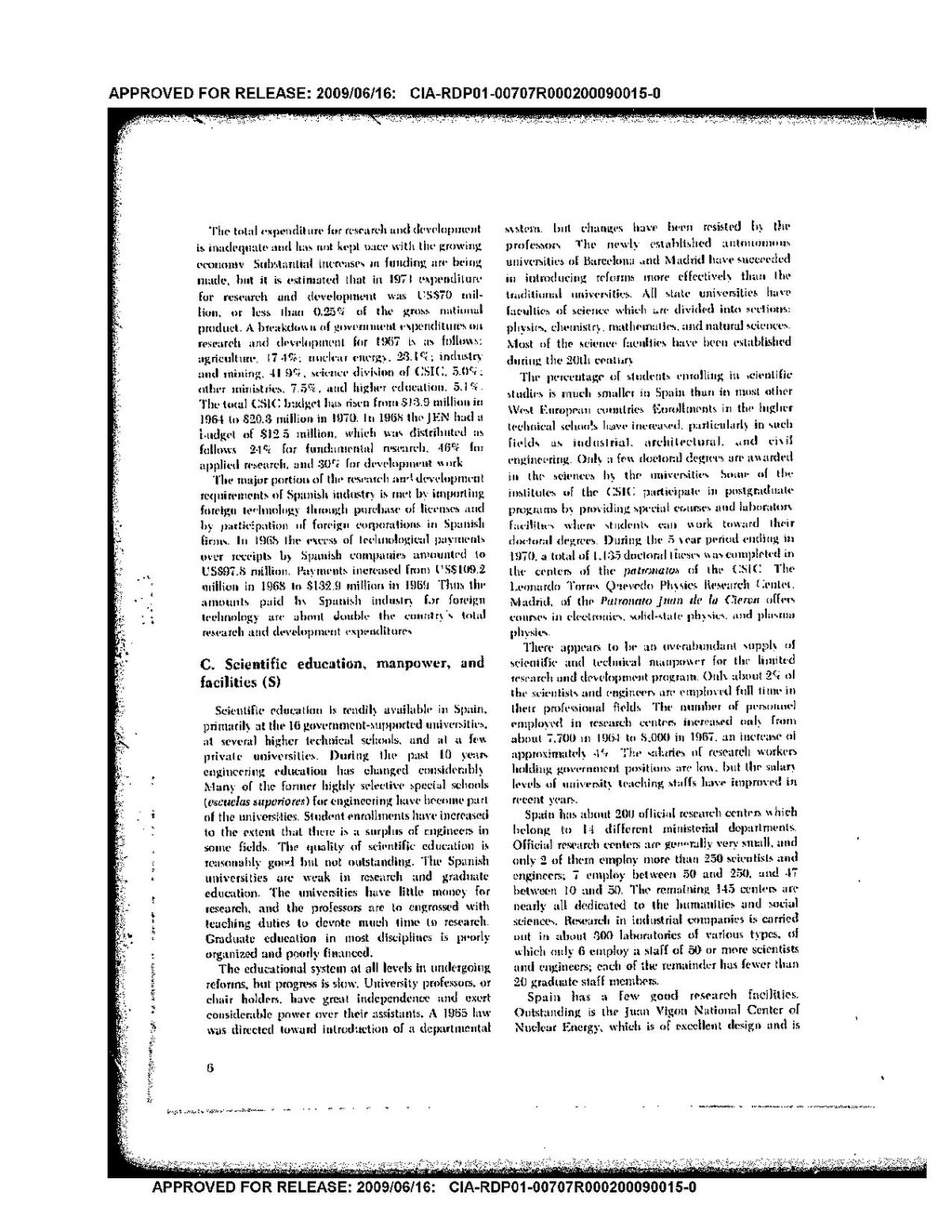APPROVED FOR RELEASE: 2009/06/16: CIA-RDP01-00707R000200090015-0
The total expenditure for research and development is inadequate and has not kept pace with the growing economy. Substantial increases in funding are being made, but it is estimated that in 1971 expenditure for research and development was US$70 million, or less than 0.25% of the gross national product. A breakdown of government expenditures on research and development for 1967 is as follows: agriculture, 17.4%; nuclear energy, 23.1%; industry and mining, 41.9%; science division of CSIC, 5.0%; other ministries, 7.5%; and higher education, 5.1%. The total CSIC budget has risen from $13.9 million in 1964 to $20.3 million in 1970. In 1968 the JEN had a budget of $12.5 million, which was distributed as follows; 24% for fundamental research, 46% for applied research, and 30% for development work.
The major portion of the research and development requirements of Spanish industry is met by importing foreign technology through purchase of licenses and by participation of foreign corporations in Spanish firms. In 1968 the excess of technological payments over receipts by Spanish companies amounted to US$97.8 million. Payments increased from US$109.2 million in 1968 to $132.9 million in 1969. Thus the amounts paid by Spanish industry for foreign technology are about double the country's total research and development expenditures.
C. Scientific education, manpower, and facilities (S)
Scientific education is readily available in Spain, primarily at the 16 government-supported universities, at several higher technical schools, and at a few private universities. During the past 10 years engineering education has changed considerably. Many of the former highly selective special schools (escuclas superiores) for engineering have become part of the universities. Student enrollments have increased to the extent that there is a surplus of engineers in some fields. The quality of scientific education is reasonable good but not outstanding. The Spanish universities are weak in research and graduate education. The universities have little money for research, and the professors are too engrossed with teaching duties to devote much time to research. Graduate education in most disciplines is poorly organized and poorly financed.
The educational system at all levels is undergoing reforms, but progress is slow. University professors, or chair holders, have great independence and exert considerable power over their assistants. A 1965 law was directed towards introduction of a departmental system, but changes have been resisted by the professors. The newly established autonomous universities of Barcelona and Madrid have succeeded in introducing reforms more effectively than the traditional universities. All state universities have faculties of science which are divided into sections; physics, chemistry, mathematics, and natural sciences. Most of the science faculties have been established during the 20th century.
The percentage of students enrolling in scientific studies is much smaller in Spain than in most other Western European countries. Enrollments in the higher technical schools have increased, particularly in such fields as industrial, architectural, and civil engineering. Only a few doctoral degrees are awarded in the sciences by the universities. Some of the institutes of the CSIC participate in postgraduate programs by providing special courses and laboratory facilities where students can work toward their doctoral degrees. During the 5-year period ending in 1970, a total of 1,135 doctoral theses were completed in the centers of the patronatos of the CSIC. The Leonardo Torres Quevedo Physics Research Center, Madrid, of the Patronato Juan de la Cierva offers courses in electronics, solid-state physics, and plasma physics.
There appears to be an overabundant supply of scientific and technical manpower for the limited research and development program. Only about 2% of the scientists and engineers are employed full time in their professional fields. The number of personnel employed in research centers increased only from about 7,700 in 1964 to 8,000 in 1967, an increase of approximately 4%. The salaries of research workers holding government positions are low, but the salary levels of university teaching staffs have improved in recent years.
Spain has about 200 official research centers which belong to 14 different ministerial departments. Official research centers are generally very small, and only 2 of them employ more than 250 scientists and engineers; 7 employ between 50 and 250; and 47 between 10 and 50. The remaining 145 centers are nearly all dedicated to the humanities and social sciences. Research in industrial companies is carried out in about 300 laboratories of various types, of which only 6 employ a staff of 50 or more scientists and engineers; each of the remainder has fewer than 20 graduate staff members.
Spain has a few good research facilities. Outstanding is the Juan Vigon National Center of Nuclear Energy, which is of excellent design and is
6
APPROVED FOR RELEASE: 2009/06/16: CIA-RDP01-00707R000200090015-0
